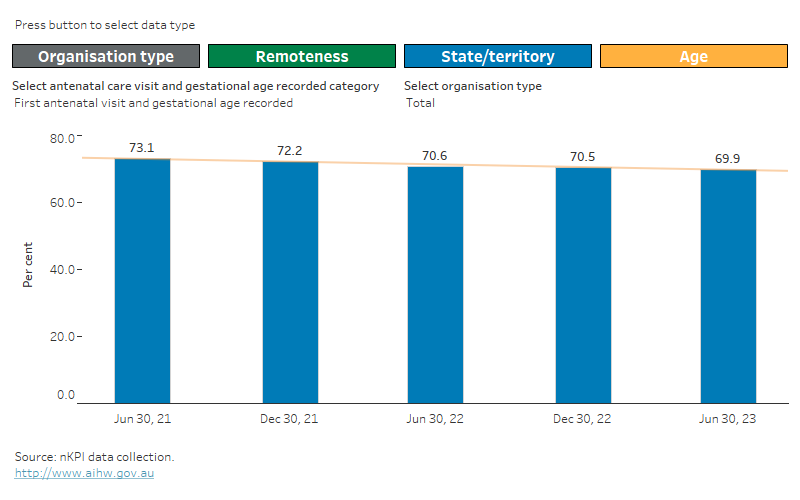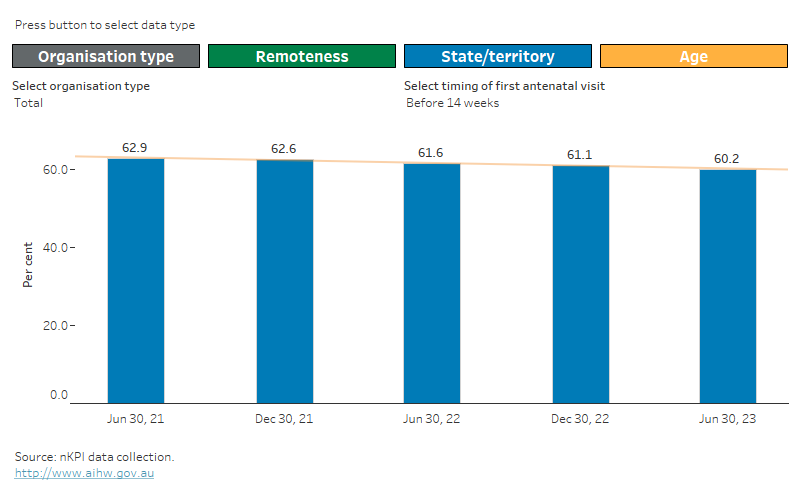First antenatal visit (PI13)
This indicator is the proportion of female First Nations regular clients who gave birth within the previous 12 months who had their first antenatal care visit recorded as either:
- before 11 weeks
- 11–13 weeks
- 14–19 weeks
- 20 or more weeks
- gestational age not recorded at first antenatal care visit or did not have an antenatal care visit.
It is reported here in 2 parts as the proportion of female First Nations regular clients who gave birth within the previous 12 months who had:
- an antenatal care visit and gestational age recorded at their first antenatal care visit
- an antenatal care visit and gestational age recorded at their first antenatal care visit, with the timing of that visit recorded as either:
- before 14 weeks
- 14–19 weeks
- 20 or more weeks.
It is collected for age groups:
- less than 20
- 20–34
- 35 and over.
There have been changes to the specification of this indicator over time. For more information see Interpreting nKPI data.
Why antenatal care is important
Antenatal care is a planned visit between a pregnant woman and a midwife or doctor to assess and improve the wellbeing of the mother and baby throughout pregnancy. It does not include visits where the sole purpose is to confirm the pregnancy.
Antenatal care provides an opportunity to find, treat, and provide advice on chronic or pre-existing conditions that might cause pregnancy-related complications, such as hypertension, diabetes, mental health problems, sexually transmitted infections, tobacco and alcohol misuse, inadequate nutrition, and unhealthy weight. Regular antenatal care, and especially that starting in the first trimester, is associated with less pregnancy-related complications and with positive maternal and child health outcomes.
The targets in the National Agreement on Closing the Gap include several aimed at children, including a target to increase the proportion of First Nations babies with a healthy birthweight to 91% by 2031 (with supporting indicators on the use of antenatal care by pregnant women).
Data from the National Perinatal Data Collection show that the proportion of First Nations mothers attending an antenatal visit in the first trimester has increased over time. First Nations mothers, however, are less likely than non-Indigenous mothers to have their first antenatal care visit in the first trimester (AIHW 2023).
At June 2023, 70% (or around 4,400) of female First Nations regular clients had an antenatal care visit and gestational age recorded at their first antenatal care visit, 30% (1,900) did not (Figure 1).
Figure 1: Whether first antenatal visit and gestational age recorded by reporting period
First antenatal visit and gestational age recorded by reporting period
This Tableau visualisations shows the percentage of female First Nations regular clients who gave birth in the last year with/without the first antenatal visit and gestational age recorded for reporting periods between June 2021 and June 2023 for either:
- organisation type (ACCHO, non-ACCHO, Total)
- remoteness area (Major cities, Inner regional, Outer regional, Remote, Very remote, Total)
- state/territory (NSW/ACT, Vic, Qld, WA, SA, Tas, NT, Total)
- age (<20, 20–34, 35 and over).
Data supporting this visualisation are available in Excel supplementary data tables at Data.

Notes
- In June 2021, specifications changed for this indicator. Data on whether or not there was antenatal care visit or the gestational age was recorded at the first antenatal care visit can be compared with previous periods with caution. For more information see Interpreting nKPI data. Data prior to June 2021 are not presented here (for consistency with Figure 2) but can be found in Archived content.
- For more information, including on interpreting changes over time, see Technical notes.
Of those who had an antenatal care visit and gestational age recorded at their first antenatal care visit:
- 60% (or around 2,600) had their visit before 14 weeks (first trimester)
- 18% (or around 770) had their visit at 14–19 weeks
- 22% (or around 960) had their visit at 20 or more weeks (Figure 2).
Figure 2: Timing of first antenatal visit by reporting period and timing of visit
Timing of first antenatal visit by select reporting period
The Tableau visualisations shows the percentage of female First Nations regular clients who gave birth in the last year by the timing of their first antenatal visit (select for before 14 weeks, 14–19 weeks, 20 or more weeks) for either:
- organisation type (ACCHO, non-ACCHO, Total)
- remoteness area (Major cities, Inner regional, Outer regional, Remote, Very remote, Total)
- state/territory (NSW/ACT, Vic, Qld, WA, SA, Tas, NT, Total)
- age (<20, 20–34, 35 and over).
Reporting periods of either June 2021, December 2021, June 2022, December 2022 or June 2023 can be selected.
Data supporting this visualisation are available in Excel supplementary data tables at Data.

Notes
- In June 2021, specifications changed for this indicator and data from that point on for the total and most visit timing categories (except ’20 or more weeks’) cannot be compared with previous periods. For more information see Interpreting nKPI data.
- Proportions are calculated using the denominator of female Indigenous regular clients who had an antenatal care visit and gestational age recorded at their first antenatal care visit.
- For more information, including on interpreting changes over time, see Technical notes.
For more information on first antenatal visit see Data.
Reference
AIHW (Australian Institute of Health and Welfare) (2023) Aboriginal and Torres Strait Islander Health Performance Framework: antenatal care, AIHW, Australian Government, accessed 11 December 2023.


